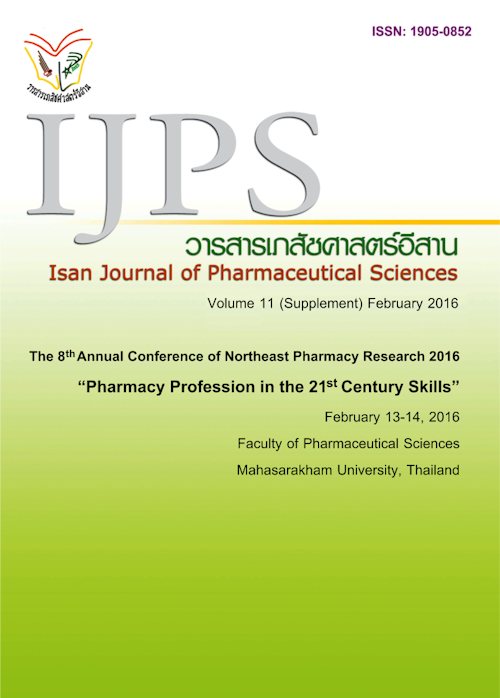Effect of Alcohol and Co-Film Former on The Physical and Mechanical Properties of Facial Mask Formulations
Main Article Content
Abstract
Introduction: The facial mask formulation is nourishment cosmetics which removes the old skin cells and develops renewable skin. However, some types of facial mask such as clay and mineral masks have been low acceptance by users because it is hard to apply and remove. Moreover, this product dries after facial application, forming sandy cracked clay regarding the low cohesion between the dried particles. Thus, the facial film masks prepared from natural or synthetic polymer have been investigated to eliminate those drawbacks. The objective of this study was to develop the facial mask and study the effect of excipients including the drying time accelerator and co-film former on the physical and mechanical properties of facial mask. Method: The facial mask formulations composed of chitosan and polyvinyl alcohol (PVA) acted as film former and co-film former, respectively. Ethanol, the drying time accelerator of film, was varied.
The physical properties of film including appearance, pH, viscosity, and drying times were carried out. Mechanical properties such as tensile strength, the percentage of elongation at break and peel force were performed. Results: The addition of PVA to chitosan film led to increase the mechanical property of film
especially the elongation at break and the adhesive strength. The film former solution mixed with 20% ethanol presented the turbid and low viscous dispersion. The higher alcohol content, the lower in drying time was observed. Conclusion: The optimized facial mask formula consisted of 2% chitosan and 1 % PVA as
film formers with 10% ethanol. Such formulation demonstrated the appropriate properties especially the drying time and the elasticity.
Article Details
In the case that some parts are used by others The author must Confirm that obtaining permission to use some of the original authors. And must attach evidence That the permission has been included
References
Beringhs AR, Rosa J, Stulzer H, Budal R, Sonaglio D. Green Clay and Aloe Vera Peel-Off Facial Masks: Response Surface Methodology Applied to the Formulation Design. AAPS PharmSciTech. 2013 2013/03/01;14(1):445-55.
Dutta P, Tripathi S, Mehrotra G, Dutta J. Perspectives for chitosan based antimicrobial films in food applications. Food chemistry. 2009;114(4):1173-82.
de Souza Costa-Júnior E, Pereira MM, Mansur HS. Properties and biocompatibility of chitosan films modified by blending with PVA and chemically crosslinked. Journal of Materials Science: Materials in Medicine. 2009;20(2):553-61.
Mi F-L, Sung H-W, Shyu S-S. Drug release from chitosan–alginate complex beads reinforced by a naturally occurring cross-linking agent. Carbohydrate Polymers. 2002;48(1):61-72.
Murillo-Carretero M, Ruano MJ, Matarredona ER, Villalobo A, Estrada C. Antiproliferative effect of nitric oxide on epidermal growth factor-responsive human neuroblastoma cells. Journal of Neurochemistry. 2002;83(1):119-31.
Zague V, De Almeida Silva D, Rolim Baby A, Mary Kaneko T, Valéria Robles Velasco M. Clay facial masks: physicochemical stability at different storage temperatures. International Journal of Cosmetic Science. 2007;29(6):488-9.
Wang X, Du Y, Luo J, Lin B, Kennedy JF. Chitosan/organic rectorite nanocomposite films: Structure, characteristic and drug delivery behaviour. Carbohydrate Polymers. 2007;69(1):41-9.


